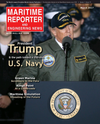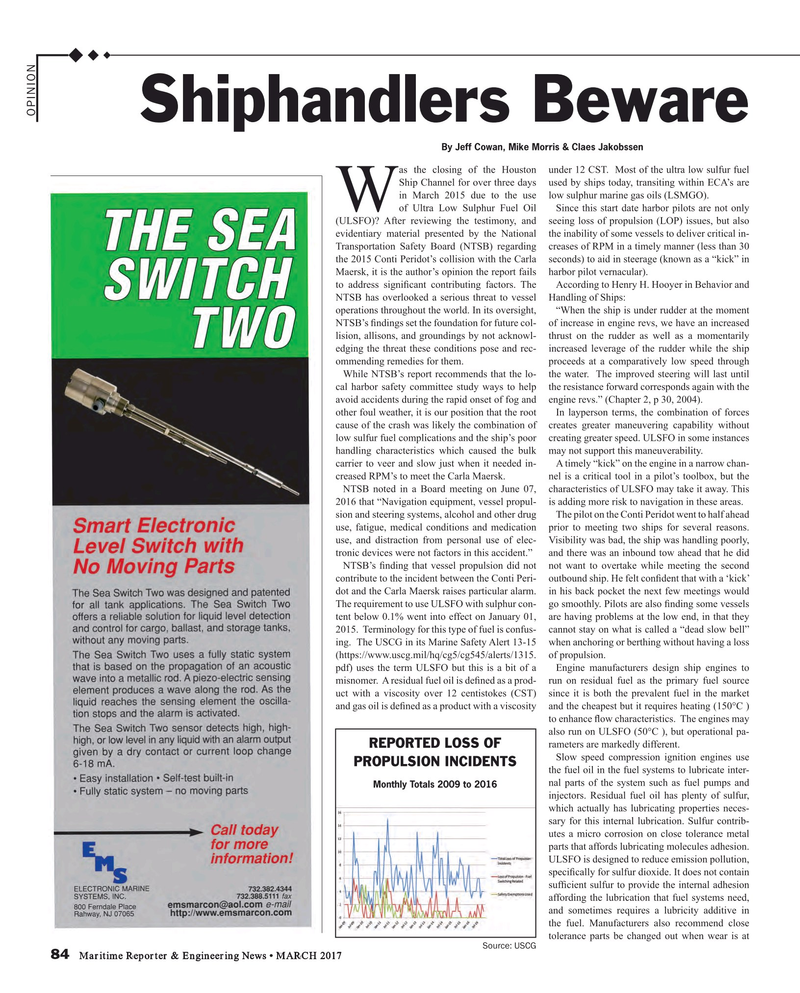
Page 84: of Maritime Reporter Magazine (March 2017)
U.S. Navy Quarterly & Maritime Simulation Technologies
Read this page in Pdf, Flash or Html5 edition of March 2017 Maritime Reporter Magazine
OPINION
Shiphandlers Beware
By Jeff Cowan, Mike Morris & Claes Jakobssen as the closing of the Houston under 12 CST. Most of the ultra low sulfur fuel
Ship Channel for over three days used by ships today, transiting within ECA’s are in March 2015 due to the use low sulphur marine gas oils (LSMGO).
Wof Ultra Low Sulphur Fuel Oil Since this start date harbor pilots are not only (ULSFO)? After reviewing the testimony, and seeing loss of propulsion (LOP) issues, but also evidentiary material presented by the National the inability of some vessels to deliver critical in-
Transportation Safety Board (NTSB) regarding creases of RPM in a timely manner (less than 30 the 2015 Conti Peridot’s collision with the Carla seconds) to aid in steerage (known as a “kick” in
Maersk, it is the author’s opinion the report fails harbor pilot vernacular).
to address signi? cant contributing factors. The According to Henry H. Hooyer in Behavior and
NTSB has overlooked a serious threat to vessel Handling of Ships: operations throughout the world. In its oversight, “When the ship is under rudder at the moment
NTSB’s ? ndings set the foundation for future col- of increase in engine revs, we have an increased lision, allisons, and groundings by not acknowl- thrust on the rudder as well as a momentarily edging the threat these conditions pose and rec- increased leverage of the rudder while the ship ommending remedies for them. proceeds at a comparatively low speed through
While NTSB’s report recommends that the lo- the water. The improved steering will last until cal harbor safety committee study ways to help the resistance forward corresponds again with the avoid accidents during the rapid onset of fog and engine revs.” (Chapter 2, p 30, 2004).
other foul weather, it is our position that the root In layperson terms, the combination of forces cause of the crash was likely the combination of creates greater maneuvering capability without low sulfur fuel complications and the ship’s poor creating greater speed. ULSFO in some instances handling characteristics which caused the bulk may not support this maneuverability.
carrier to veer and slow just when it needed in- A timely “kick” on the engine in a narrow chan- creased RPM’s to meet the Carla Maersk. nel is a critical tool in a pilot’s toolbox, but the
NTSB noted in a Board meeting on June 07, characteristics of ULSFO may take it away. This 2016 that “Navigation equipment, vessel propul- is adding more risk to navigation in these areas.
sion and steering systems, alcohol and other drug The pilot on the Conti Peridot went to half ahead use, fatigue, medical conditions and medication prior to meeting two ships for several reasons. use, and distraction from personal use of elec- Visibility was bad, the ship was handling poorly, tronic devices were not factors in this accident.” and there was an inbound tow ahead that he did
NTSB’s ? nding that vessel propulsion did not not want to overtake while meeting the second contribute to the incident between the Conti Peri- outbound ship. He felt con? dent that with a ‘kick’ dot and the Carla Maersk raises particular alarm. in his back pocket the next few meetings would
The requirement to use ULSFO with sulphur con- go smoothly. Pilots are also ? nding some vessels tent below 0.1% went into effect on January 01, are having problems at the low end, in that they 2015. Terminology for this type of fuel is confus- cannot stay on what is called a “dead slow bell” ing. The USCG in its Marine Safety Alert 13-15 when anchoring or berthing without having a loss (https://www.uscg.mil/hq/cg5/cg545/alerts/1315. of propulsion. pdf) uses the term ULSFO but this is a bit of a Engine manufacturers design ship engines to misnomer. A residual fuel oil is de? ned as a prod- run on residual fuel as the primary fuel source uct with a viscosity over 12 centistokes (CST) since it is both the prevalent fuel in the market and gas oil is de? ned as a product with a viscosity and the cheapest but it requires heating (150°C ) to enhance ? ow characteristics. The engines may also run on ULSFO (50°C ), but operational pa- rameters are markedly different.
REPORTED LOSS OF
Slow speed compression ignition engines use
PROPULSION INCIDENTS the fuel oil in the fuel systems to lubricate inter- nal parts of the system such as fuel pumps and
Monthly Totals 2009 to 2016 injectors. Residual fuel oil has plenty of sulfur, which actually has lubricating properties neces- sary for this internal lubrication. Sulfur contrib- utes a micro corrosion on close tolerance metal parts that affords lubricating molecules adhesion.
ULSFO is designed to reduce emission pollution, speci? cally for sulfur dioxide. It does not contain suf? cient sulfur to provide the internal adhesion affording the lubrication that fuel systems need, and sometimes requires a lubricity additive in the fuel. Manufacturers also recommend close tolerance parts be changed out when wear is at
Source: USCG 84 Maritime Reporter & Engineering News • MARCH 2017
MR #3 (82-89).indd 84 MR #3 (82-89).indd 84 3/7/2017 5:48:16 PM3/7/2017 5:48:16 PM

 83
83

 85
85
